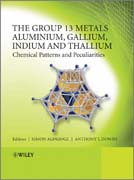
The group 13 metals aluminium, gallium, indium and thallium: chemical patterns and peculiarities
Aldridge, Simon
Downs, Anthony J.
INDICE: Chapter 1 Introduction: New Light on the Chemistry of the Group 13 Metals Anthony J. Downs and Hans-Jörg Himmel 1.1. Reprise of the General Features of the Group 13 Elements. 1.2. Developments in Methodology. 1.3. Redox Chemistry of the Group 13 Metals: Access to Oxidation States Lower than +3. 1.4. Bonding Aspects. 1.5. Solid Compounds with Specific Electronic, Structural or Other Properties. 1.6. Coordination Chemistry of M(III) Compounds. 1.7. Mediation of Organic Transformations by Group 13 Metal Compounds. 1.8. References Chapter 2 The Chemistry of the Group 13 Metals in the +3 Oxidation State: SimpleInorganic Compounds Simon Aldridge 2.1. Introduction. 2.2. Hydrides. 2.3 Halides and Pseudohalides. 2.4 Oxides and Oxo- derivatives. 2.5. Chalcogenides andChalco- Derivatives. 2.6. Compounds with Bonds to Group 15 Atoms. 2.7. References Chapter 3 Formal Oxidation State +3: Organometallic Chemistry Simon Aldridge, Anthony J. Downs and Deborah L. Kays 3.1. General Introduction. 3.2. Organo Derivatives with a MetalCarbon Primary Framework. 3.3. Derivatives with Bonds to Group 15 Elements. 3.4. Derivatives with Bonds to Group 16 Elements. 3.5. Organometal Halides. 3.6. Organometal Hydrides. 3.7. d-Block and f-block compounds with organo-Group 13 metal(III) fragments. 3.8. References. Chapter 4. Formal Oxidation State +2: Metal-Metal Bonded vs. Mononuclear Derivatives Werner Uhl and Marcus Layh 4.1 Introduction 4.2 Subhalides containing M-M bonds 4.3 Homoleptic chalcogen compounds 4.4 Homoleptic dielement compounds with pnicogen atoms coordinated to the M-M bonds 4.5 Heteroleptic compounds containing donor atoms of Groups 15 to 17 4.6 Homoleptic dinuclear organoelement(II) compounds 4.7 Heteroleptic organoelement(II) compounds 4.8 Mononuclear element(II) compounds 4.9 References Chapter 5 The Chemistry of the Group 13 Metals in the+1 Oxidation State Cameron Jones and Andreas Stasch 5.1. Introduction. 5.2. Aluminum. 5.3. Gallium. 5.4. Indium. 5.5. Thallium. 5.6. Reference Chapter 6 Mixed or Intermediate Valence Group 13 Metal Compounds Benjamin F. T. Cooper andCharles L. B. Macdonal 6.1. Mixed Valency 6.2. Halides 6.3. Arene-stabilized Mixed Valent Species 6.4. Chalcogenide and other Non-Halide Salts 6.5. Discretely Bonded Systems 6.6. Donor-Acceptor Compounds 6.7. Conclusions 6.8. References Chapter 7. Aluminium and Gallium Clusters: Metalloid Clusters and their Relation to the Bulk Phases, to Naked Clusters, and to Nanoscaled Materials Hansgeorg Schnöckel and Andreas Schnepf 7.1. Introduction 7.2. Explanations of Special Terms 7.3. The Naked Al13- Cluster 7.4. Metalloid Al/Ga Clusters 7.5. Interactions between Cluster Species within the Crystal 7.6. Summary and Outlook 7.7. References Chapter 8 8. Simple And Mixed Metal Oxides And Hydroxides: Solids With E
- ISBN: 978-0-470-68191-6
- Editorial: John Wiley & Sons
- Encuadernacion: Cartoné
- Páginas: 736
- Fecha Publicación: 18/03/2011
- Nº Volúmenes: 1
- Idioma: Inglés
